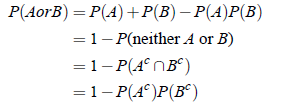SKEDSOFT
Addition Theorem of Probability:
If A1,A2, . . . , Ak be k mutually exclusive events on a sample space associated with a random experiment, then the probability of happening one of them is the sum of their individual probabilities. In symbols,
P(A1 A2 . . . Ak) = P(A1) P(A2) . . . P(Ak)
or
P(A1 ∪ A2 ∪. . .∪ Ak) = P(A1) P(A2) . . . P(Ak)
Proof: Let total ways = N. Let a1,a2, . . . ,ak be the favorable ways to the events A1,A2, . . . ,Ak respectively. Then the number of favorable ways to any one of the events = a1 a2 . . . ak

Conditional Probability:
The probability that the event B will occur, it being known that A has occurred is called the conditional probability of B and is denoted by P(B/A).In symbols,
Conditional probability of B when A has happened = 

Multiplication Theorem of Probability:
1. The probability of happening of the two independent events A and B together is equal to the product of their individual probabilities. That is
P( A ∩ B = P(A) P(B )
2. If A and B are not independent, then the probability P( A ∩ B ) of their simultaneous occurrence is equal to the product of the probability of A, P (A) and the conditional probability P (B/A). In symbols
P( A ∩ B ) = P (A) P(B/A)
or
P( A ∩ B ) = P(B) P(A/B)
Specific Formulas:
1. If P( A ∩ B ) = P(A) P(B), then

2. If the events A and B are independent

3. If the events A and B are independent
